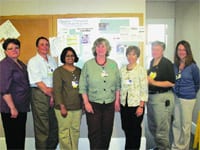On the Front Line Cooley Dickinson Makes a Difference in Patient Care with Microsystems
The work of Microsystems at Cooley Dickinson Hospital is invisible to patients. But the impact of those efforts is being felt all over the facility.
Recently, the work of the Case Management Department in implementing Microsystems was highlighted in an article in the clinical journal Professional Case Management, co-written by Tammy Cole-Poklewski, the hospital’s director of Quality, Patient Safety & Care Management, and Jennifer Higgins, clinical trials coordinator.
The article in the April issue outlines the changes in work processes that have occurred at CDH over the past two years.
“We implemented 360 degrees of change in our department,” Cole-Poklewski said. “With the help of the Microsystems framework, we adopted a completely new way of doing our jobs.”
Microsystems is essentially a way to improve overall efficiency and quality of care in a hospital starting from the bedside.
“It was developed out of Dartmouth several years ago,” said Cole-Poklewski. “The basic concept is that you work to improve care at the closest point to the patient, and it involves the frontline staff that provides direct patient care to the patient. There’s a buy-in from the staff that actually does the work.
“The assumption,” she explained, “is that they know the work that needs to be done, so it’s much easier for them to develop a new way to work, rather than have it come from someone higher up in the organization who really doesn’t understand that work.”
She said the focus on frontline workers to create efficiencies and improve care isn’t unlike the Toyota lean model for improvement.
“When the staff develops a new way to do their work, you do what’s called a small test of change,” Cole-Poklewski said. “Through the testing, you find out what works and what doesn’t work. Then you tweak it and do another test of change” — and repeat the cycle as necessary.
Painful Discoveries
One example is Cooley Dickinson’s development of palliative screening to improve care, a process that began in 2008.
“We looked at a group of patients over a period of six months, and found out that we had some patients continually coming back to the hospital,” Cole-Poklewski said. They found that a significant number of readmissions were directly related to poor control of pain or other symptoms related to malignant illness.
As a result, the case managers decided to screen all admitted patients for the potential benefits of palliative care. There was one problem: a tool — a questionnaire, actually — used nationally for that purpose would have added about 20 minutes to each patient visit, an untenable number. But after consulting with a physician, the Microsystems team was able to cut the process to three questions, and only a few minutes.
They tried it out on one unit, then two, both with success. Using the new screening tool, the hospital determined that 7{06cf2b9696b159f874511d23dbc893eb1ac83014175ed30550cfff22781411e5} of all admitted patients screened positive for palliative care physician consults. “So,” Cole-Poklewski said, there’s a conversation early on, during admission, between the doctor and nurse: ‘is palliative care something the patient might benefit from?’”
The hospital eventually determined that patients who received the consult had an average length of stay that was one-half day less than those without the consult. This reduction in length of stay offers significant cost savings to the hospital.
But there’s more.
“We found that the hospital’s overall fatality rate from heart failure decreases,” she said, “and we think that has to with the fact that we’re identifying really vulnerable people early on by having this conversation.”
It’s a perfect example, she said, of the way that Microsystems can increase efficiency, reduce costs to the health system, and — most important — possibly save more lives by doing so.
Systemic Changes
Another change had to do with the patient-discharge process and cutting down on repeat admissions by streamlining the information patients receive about self-care. Yet another had to do with standardizing communications between the hospital and community care entities like home care and visiting nurses.
In fact, Microsystems teams have been established in about 20 hospital departments. Clearly, Cole-Poklewski and her team — and the entire hospital, for that matter — have bought into the idea that there’s always an area of workflow that can be improved, and the most effective changes are going to come from the front line.
Even during a time of staff reductions, which Cooley Dickinson faced in 2008, employees involved in Microsystems experienced increased satisfaction in their jobs, she said, not only because of the positive changes being made in work flow, but because they had a direct hand in creating that change.
“I encourage them, I ask them questions, we brainstorm and think through what might be the next test of change,” she said of her Case Management staff. “We’re constantly looking at the literature and seeing what other hospitals can do.”
Because of its success, now Cooley Dickinson Hospital is part of that literature, too.

